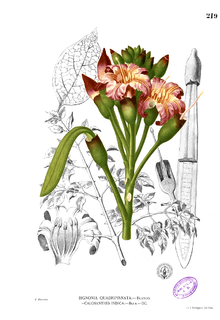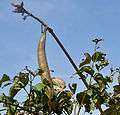Oroxylum indicum
Oroxylum indicum is a species of flowering plant belonging to the monotypic genus Oroxylum and the family Bignoniaceae, and is commonly called midnight horror,[3] oroxylum,[3] Indian trumpet flower,[4] broken bones,[5] Indian caper, or tree of Damocles.[6] It can reach a height of 18 metres (59 ft). Various segments of the tree are used in traditional medicine.[6]
| Oroxylum indicum | |
|---|---|
 | |
| Plate from book Flora de Filipinas, Gran edicion, Atlas I. by Francisco Manuel Blanco, 1880-1883? where name is Bignonia quadripinnata, Blanco. | |
| Scientific classification | |
| Kingdom: | Plantae |
| Clade: | Tracheophytes |
| Clade: | Angiosperms |
| Clade: | Eudicots |
| Clade: | Asterids |
| Order: | Lamiales |
| Family: | Bignoniaceae |
| Tribe: | Oroxyleae |
| Genus: | Oroxylum Vent. |
| Species: | O. indicum |
| Binomial name | |
| Oroxylum indicum | |
| Synonyms[1] | |
| |
Description
The large leaf stalks wither and fall off the tree and collect near the base of the trunk, appearing to look like a pile of broken limb bones. The pinnate leaves are approximately 1 metre (3.3 ft) in length and comparably wide,[5][7] borne on petioles or stalks up to 2 metres (6.6 ft) in length, making this the largest of all dicot tree leaves, which are quadripinnate (leaflets display four orders of branching).[8]
The tree is a night-bloomer and flowers are adapted to natural pollination by bats.[5] They form enormous seed pods – the fruits – are up to 1.5 metres (4.9 ft) long that hang down from bare branches, resembling swords.[5][9] The long fruits curve downward and resemble the wings of a large bird or dangling sickles or swords in the night, giving the name "tree of Damocles".[6] The seeds are round with papery wings.[10]
Distribution
Ooroxylum indicum is native to the Indian subcontinent, the Himalayan foothills with a part extending to Bhutan and southern China, Indochina and the Malesia regions. In Vietnam, the tree is called núc nác (sometimes sò đo), and specimens can be found in Cat Tien National Park.
It is visible in the forest biome of Manas National Park in Assam, India. It is found, raised and planted in large number in the forest areas of the Banswara district in the state of Rajasthan in India. It is reported in the list of rare, endangered and threatened plants of Kerala (South India). It is also found in Sri Lanka.[11]
Ecology
Oroxylum indicum lives in relationship with the actinomycete Pseudonocardia oroxyli present in the soil surrounding the roots.[12] Septobasidium bogoriense is a fungal species responsible for velvet blight in O. indicum.
Phytochemistry
Various segments of O. indicum, including leaves, root bark, heartwood, and seeds, contain diverse phytochemicals, such as prunetin, sitosterol, oroxindin, oroxylin-A, biochanin-A, ellagic acid, tetuin, anthraquinone, and emodin.[6][13] Several of the compounds are under preliminary research to identify their potential biological properties.[6]
Uses
The tree is often grown as an ornamental plant for its strange appearance. Materials used include the wood, tannins and dyestuffs.[14]
In marriage rituals
The plant is used by the Kirat, Sunuwar, Rai, Limbu, Yakha, Tamang in Nepal, the Thai in Thailand and the Lao in Laos.
In the Himalayas, people hang sculptures or garlands made from O. indicum (Skr. shyonaka) seeds from the roof of their homes in belief they provide protection.[15]
As food
It is a plant with edible leaves and stems.[16] The large young pods, known as Lin mai or Lin fa in Loei, are eaten especially in Thailand and Laos. They are first grilled over charcoal fire and then the bitter inner pulp is usually scraped and eaten along with lap.[17] Known as karongkandai among the Bodos of north east India, its flowers and fruit are eaten as a bitter side dish with rice. It is often prepared with fermented or dried fish and believed by them to have medicinal uses. The pods also eaten by Chakma people in Chittagong hill tracts of Bangladesh and India. Its called "Hona Gulo 𑄦𑄧𑄚 𑄉𑄪𑄣𑄮" in Chakma language
Gallery
 Flowers
Flowers Leaves
Leaves Fruit
Fruit The large Oroxylum indicum pods sold at a market in Bangkok, Thailand
The large Oroxylum indicum pods sold at a market in Bangkok, Thailand
See also
References
- "Oroxylum indicum (L.) Kurz". World Checklist of Selected Plant Families (WCSP). Royal Botanic Gardens, Kew. Retrieved 31 Mar 2016 – via The Plant List.
- "The International Plant Names Index".
- "Oroxylum indicum". Germplasm Resources Information Network (GRIN). Agricultural Research Service (ARS), United States Department of Agriculture (USDA). Retrieved 15 December 2017.
- "Ecoport".
- "Broken bones tree". Flowers of India. Retrieved 11 December 2017.
- Chaudhary, AK; Singh, V; Chaudhary, A. K (2011). "A Review on the Taxonomy, Ethnobotany, Chemistry and Pharmacology of Oroxylum indicum Vent". Indian Journal of Pharmaceutical Sciences. 73 (5): 483–490. doi:10.4103/0250-474X.98981. PMC 3425058. PMID 22923859.
- Phillipps, Anthea (22 April 2012). "The Midnight Horror Tree". Retrieved 5 September 2012.
- Corner, Prof. E.J.H. (1952). Wayside Trees of Malaya. 1. Singapore: Govt. Printing Office. p. 166.
- Barwick M, van der Schans A (2004). Tropical and Subtropical Trees - An Encyclopedia. Portland: Timber Press. p. 304.
- "Oroxylum indicum". eFloras.org. Dinghushan Plant Checklist, Chinese Academy of Science.
- Theobald, W.L. (1981). Bignoniace. In: Dassanayake, M.D. and Fosberg, F.R. (Eds.). A Revised Handbook to the Flora of Ceylon. Amerind Publishing Co. Pvt. Ltd., New Delhi.
- Gu, Qiang; Luo, Hongli; Zheng, Wen; Liu, Zhiheng; Huang, Ying (1 September 2006). "Pseudonocardia oroxyli sp. nov., a novel actinomycete isolated from surface-sterilized Oroxylum indicum root". Int. J. Syst. Evol. Microbiol. 56 (Pt 9): 2193–2197. doi:10.1099/ijs.0.64385-0. PMID 16957120.
- Shah, R. C.; Mehta, C. R.; Wheeler, T. S. (1 January 1936). "131. The constitution of oroxylin-A, a yellow colouring matter from the root-bark of Oroxylum indicum, vent". J. Chem. Soc.: 591. doi:10.1039/JR9360000591.
- O'Neill, Alexander; et al. (2017-03-29). "Integrating ethnobiological knowledge into biodiversity conservation in the Eastern Himalayas". Journal of Ethnobiology and Ethnomedicine. 13 (21). doi:10.1186/s13002-017-0148-9. PMC 5372287. PMID 28356115. Retrieved 2017-05-11.
- Storrs A, Storrs J (1990). Trees and Shrubs of Nepal and the Himalayas; page 200. Pilgrims Books House. ISBN 9747315432.CS1 maint: uses authors parameter (link)
- "ePIC - Detailed results from SEPASAL for oroxylum indicum".
- Thai Dishes, Central Part And South Archived March 30, 2012, at the Wayback Machine
- Doshi, K; Ilanchezhian, R; Acharya, R; Patel, B. R.; Ravishankar, B (2012). "Anti-inflammatory activity of root bark and stem bark of Shyonaka". Journal of Ayurveda and Integrative Medicine. 3 (4): 194–197. doi:10.4103/0975-9476.104434. PMC 3545239. PMID 23326090.
- Jayaweera, D.M.A. (1981). Medicinal Plants (Indigenous and Exotic) Used in Ceylon. Part I (Acanthaceae – Burseraceae). National Science Council of Sri Lanka, Colombo.
| Wikimedia Commons has media related to Oroxylum indicum. |